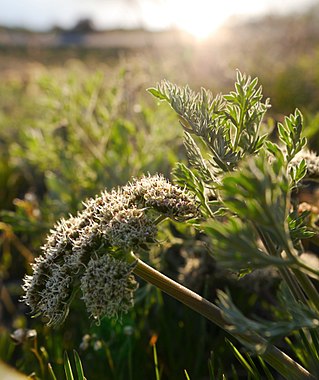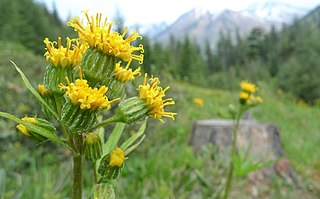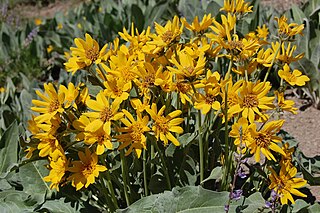
Eriophyllum lanatum, with the common names common woolly sunflower, Oregon sunshine and golden yarrow, is a common, widespread, North American plant in the family Asteraceae.

Cornus canadensis is a species of flowering plant in the dogwood family Cornaceae, native to eastern Asia and North America. Common names include Canadian dwarf cornel, Canadian bunchberry, quatre-temps, crackerberry, and creeping dogwood. Unlike its relatives, which are for the most part substantial trees and shrubs, C. canadensis is a creeping, rhizomatous perennial growing to about 20 centimetres tall.

Linum perenne, the perennial flax, blue flax or lint, is a flowering plant in the family Linaceae, native to Europe, primarily in the Alps and locally in England. It has been introduced into North America, where it can be found on mountain ridges, wooded areas, and in sandy plain habitats of the sagebrush steppe, growing near sagebrush and rabbitbrush (Chrysothamnus).

Lomatium macrocarpum is a perennial flowering plant in the carrot family known by the common names bigseed lomatium, biscuit root or bigseed biscuitroot. It is native to much of western North America, where it can be found in various types of habitat, including the grasslands of the Great Plains, and particularly in rocky areas. It is a spreading or erect perennial herb growing up to about half a meter long with hairy, gray-green herbage. The grayish basal leaves are up to about 24 centimetres (9.4 in) long and are intricately divided into many small, narrow segments. The inflorescence bears an umbel of yellowish, greenish, purplish, or white flowers, growing from a lateral stem. The fruit is a compressed, winged, round or oval disc up to about 2 cm long.

Phoenicaulis is a monotypic genus of flowering plants in the family Brassicaceae found in western North America. It contains the single species Phoenicaulis cheiranthoides, which is known by the common names daggerpod and wallflower phoenicaulis. The genus name means 'reddish-purple stems', probably in reference to the tendency for the stems to take on such a color, and the species name means 'hand of flowers'.

Cacaliopsis is a monotypic genus of flowering plants in the aster family, Asteraceae, containing the single species Cacaliopsis nardosmia. It is known by the common name silvercrown. It is native to western North America.

Claytonia lanceolata is a species of wildflower in the family Montiaceae, known by the common names lanceleaf springbeauty and western springbeauty.

Eremogone aculeata is a species of flowering plant in the family Caryophyllaceae known by the common name prickly sandwort. It is native to the western United States, where it grows in the southern sagebrush steppe, mountainous areas, and volcanic soils, as well as on rocky slopes.

Balsamorhiza sagittata is a North American species of flowering plant in the tribe Heliantheae of the family Asteraceae known by the common name arrowleaf balsamroot. Also sometimes called Oregon sunflower, it is widespread across western Canada and much of the western United States.

Crepis acuminata is a North American species of flowering plant in the family Asteraceae known by the common name tapertip hawksbeard. It is native to the western United States where it grows in many types of open habitat.

Lithophragma parviflorum is a species of flowering plant in the saxifrage family known by the common name smallflower woodland star. It is native to much of western North America from British Columbia to California to South Dakota and Nebraska, where it grows in several types of open habitat. It is a rhizomatous perennial herb growing erect or leaning with a naked flowering stem. The leaves are mainly located low on the stem, each cut into three lobes or divided into three lobed leaflets. The stem bears up to 14 flowers, each in a cuplike calyx of red or green sepals. The five petals are bright white, up to 1.6 centimeters long, and usually divided into three toothlike lobes.

Lupinus argenteus is a species of lupine known by the common name silvery lupine. It is native to much of western North America from the southwestern Canadian provinces to the southwestern and midwestern United States, where it grows in several types of habitats, including sagebrush, grassland, and forests.

Ribes cereum is a species of currant known by the common names wax currant and squaw currant; the pedicellare variety is known as whisky currant. The species is native to western North America.

Stanleya elata is a species of flowering plant in the family Brassicaceae known by the common name Panamint princesplume. It is native to the desert mountains of eastern California and western Nevada, where it grows in rocky and scrubby habitat types. It may also occur in Arizona. It is a perennial herb producing one or more erect stems reaching about 1.5 meters in maximum height. They are hairless and often waxy in texture. The thick, leathery leaves have lance-shaped or oblong blades with smooth or toothed edges measuring up to 15 centimeters long. They are borne on petioles. The top of the stem is occupied by a long inflorescence which is a dense, snaking raceme of many flowers. Each flower has four narrow, threadlike yellow or whitish petals each about a centimeter long and a millimeter wide. The fruit is a long, thin, wormlike silique which may be 10 centimeters in length. It contains tiny seeds.

Stanleya viridiflora is a species of flowering plant in the family Brassicaceae known as green princesplume and green-flowered prince's plume. It is native to the western United States, where it occurs in sagebrush and plateau habitat, often on rocky calcareous, sandstone, clay, shale, or volcanic soils.

Trautvetteria caroliniensis is a species of flowering plant in the family Ranunculaceae native to North America. It is known by the common names Carolina bugbane, false bugbane, and tassel-rue. The genus is named for the botanist Ernst Rudolf von Trautvetter.

Triteleia grandiflora is a species of flowering plant known by the common names largeflower triteleia, largeflower tripletlily, and wild hyacinth.

Wyethia mollis is a species of flowering plant in the family Asteraceae known by the common name woolly mule's ears. The plant is hairy to woolly in texture, sometimes losing its hairs with age.

Liatris punctata is a species of flowering plant in the family Asteraceae known by the common names dotted gayfeather, dotted blazingstar, and narrow-leaved blazingstar. It is native to North America, where it occurs throughout the plains of central Canada, the central United States, and northern Mexico.

Linanthus pungens is a species of flowering plant in the phlox family known by the common names granite prickly-phlox and granite gilia. It is native to western North America from British Columbia to Baja California and east to Montana and New Mexico.





















